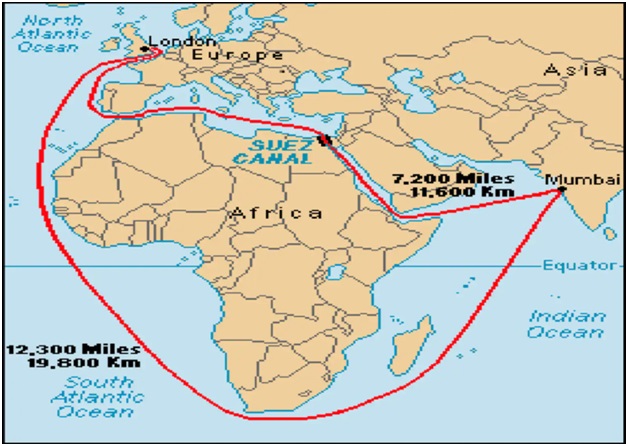Ben Gurion Canal: An Alternative to the Suez Canal (Indian Express)

- 11 Nov 2023
Why is it in the News?
Speculation suggests that Israel's desire to control the Gaza Strip, including the elimination of Hamas, may be tied to a long-debated economic opportunity, the Ben Gurion Canal Project.
Historical Context: Ben Gurion Canal Project:
- This ambitious project aims to chart a course from the Red Sea to the Mediterranean, echoing historic initiatives such as the Suez Canal, which has long been a pivotal maritime route since its completion in the 19th century.
- The proposed Ben Gurion Canal not only signals Israel’s aspirations to claim a stake in global trade dynamics but also reflects the ongoing quest to expand its geopolitical influence, a narrative that has been part of the region’s history since Israel’s establishment in 1948.
A Rivalry Revived
- The Ben Gurion Canal, if completed, would challenge the supremacy of the Suez Canal, potentially diverting commerce and reshaping economic currents.
- The strategic move can be seen as a continuation of the historical tensions that saw Israel and Egypt at odds during the Suez Crisis in 1956, where control over this critical passageway was a central issue.
About the Ben Gurion Canal Project:
- The Ben Gurion Canal Project, named after Israel’s founding father David Ben-Gurion (1886-1973), remains one of the most ambitious infrastructure projects ever planned on paper.
- It was first envisioned in the 1960s to create an alternative route to the Suez Canal, potentially enhancing economic prospects in the region.
- Estimated cost may exceed $100 billion.
- The idea is to cut a canal through the Israeli-controlled Negev Desert from the tip of the Gulf of Aqaba — the eastern arm of the Red Sea that juts into Israel’s southern tip and south-western Jordan — to the Eastern Mediterranean coast.
Historical Significance of Suez Canal:
- Upon its 1869 opening, the Suez Canal transformed global maritime trade.
- Linking the Mediterranean and Red Seas via the Isthmus of Suez, it facilitated direct ship passage between Europe and Asia, circumventing the need to navigate around the entirety of Africa.
- The canal significantly reduced the travel distance between London and Bombay (now Mumbai) by over 41 percent.
- During the 2022-23 fiscal year, approximately 26,000 vessels traversed the Suez Canal, contributing to nearly 13 percent of global shipping.
What are the Issues with the Suez Canal?
- The Suez Canal, stretching 193 km in length, 205 m in width, and 24 m in depth, stands as the world's largest shipping bottleneck.
- Despite being widened and deepened over the years, it remains perennially congested, with long queues at either end.
- In March 2021, the mammoth cargo ship Ever Given got stuck in the canal, blocking passage for more than a week.
- It was estimated that the resulting “traffic jam” held up an estimated $ 9.6 billion of goods every day.
- Also, Egypt’s control over the waterway has been a source of conflict for almost 70 years now.
- In 1956, after President Gamal Abdel Nasser (1918-70) decided to nationalise the canal, war broke out, with the UK, France, and Israel attacking Egypt in order to regain control.
- The Suez Crisis ended in a military victory for the aggressors but an overwhelming political victory for Egypt, which kept control over the canal, which was shut for more than six months due to the conflict.
- This was also a pivotal moment in the Cold War, with Soviet threats of intervention key to stopping the allied aggression against Egypt.
- The Suez Canal was also the focal point of both the 1967 and 1973 Arab-Israeli wars, and was shut from 1967-75.
- However, the canal holds immense significance for Egypt's economy.
- The Suez Canal Authority collects all toll revenue generated, along with the local economic advantages it provides.
- In the 2022-23 fiscal year, toll revenues reached a record $9.4 billion for Egypt's Suez Canal Authority, contributing to almost 2 percent of Egypt's GDP, which stood at $476.8 billion, as per the World Bank.
Thus, for the West, a shipping lane through Israel would be ideal:
- The idea of a new shipping route through Israel has long interested the West.
- A declassified 1963 US government memo proposed using nuclear explosives to create a 160-mile sea-level canal across Israel, connecting the Mediterranean to the Gulf of Aqaba.
- This alternative to the Suez Canal was seen as strategically important and potentially beneficial for regional economic development.
What is preventing Israel from constructing the canal?
- Cost and Complexity: One of the primary obstacles was the immense cost and complexity of such an endeavor.
- Estimates suggested a price tag of up to $100 billion, significantly higher than the potential cost of widening the existing Suez Canal to address its traffic issues.
- Consideration of Nuclear Excavation: Due to the high cost of conventional excavation, planners explored the controversial concept of using nuclear explosives for construction, as indicated in a declassified 1963 US government memorandum.
- Of course, this is also a very dangerous choice due to the possibility of radioactive fallout.
- Geographical Limitations: The proposed route faced challenges due to the topography and terrain, resulting in a planned canal that was over 100 kilometers longer than the Suez Canal.
- Economic Viability and Preference for Shorter Routes: Even if the project were to be realized, concerns existed about the economic viability as many ships might continue to favor the shorter, established route via the Suez Canal.
- Geopolitical Challenges: The region's ongoing military threats, including the constant risk from conflicts and attacks, presented significant concerns for the feasibility and security of a canal carrying billions of dollars in freight daily.
